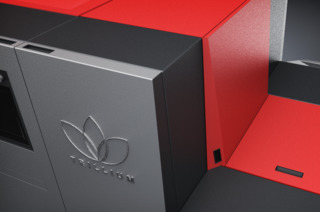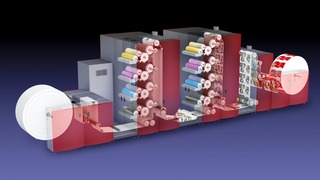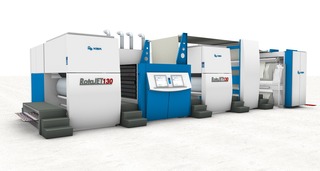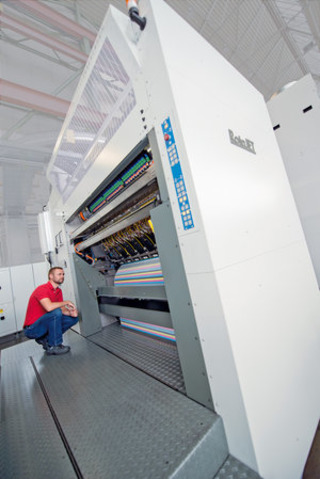19-inch Buzz: Is ‘Half-size’ Digital Width for You?
Demand continues to grow for 'B2' format digital sheet- and web-fed presses, as 75% of users report expanded customer bases.
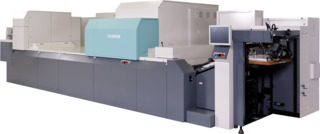
Readers familiar with conventional offset print parlance know that a “B2” size sheet (19.7x27.8 inches) is half the dimension of a 27.8 x 39.4 inch “B1” size sheet used on 40-inch sheetfed-offset presses. Hence, the “half-size” descriptor often is used to classify these printing machines. The maximum sheet size for most cut-sheet digital presses was 13 inches wide by 19 inches long – until seven years ago, when Fuji Xerox introduced the Jet Press 720, a sheetfed inkjet press in the popular B2 offset format.
Four years later, HP shook up the printing world with its nearly 21-inch-wide Indigo 10000 model featuring a maximum sheet size of 20.9x29.5 inches: quite large for a digital sheetfed device. The 29-inch buzz was loud and clear leading up to drupa 2012, and B2 digital has, indeed, proven to be a game-changing technology for many commercial print firms.
Other original equipment manufacturers (OEMs), including Canon/Océ, Dainippon Screen, Delphax Technologies, MGI Digital Graphic Technology, and Ryobi MHI, have stepped up to the half-size plate in the past 34 months. Already, more than 140 B2 digital installations are in place worldwide, according to2014 research conducted by InfoTrends. While that may seem like a small number, “it actually represents a great achievement in only about two years by just a few suppliers,” the report says, adding this bottom-line note:. “The B2 color digital presses commonly cost $1 million or more, so (all together) those placements amounted to well over $100 million in sales.”
In its study, InfoTrends surveyed 200 printing companies not owning a B2 digital color press and found that market awareness is still low. Most of the market is still not familiar with the choices that are available; therefore, only 17 percent of all responding companies are considering investing in B2 digital.
Many manufacturers tout the advantages of B2 devices, such as pioneering Fujifilm’s aforementioned J Press models. “The 720S [sheetfed] and 720F [for folding cartons] are establishing a completely new product category in the market,” said Stephen Sanker, global marketing group director for Fuji production inkjet systems. “This new platform enables Fujifilm to deliver game-changing image quality.
Fujifilm’s new platform features important developments to ensure end users have the ability to maintain and operate at optimum levels, Sanker noted. “The 720S not only enables them to increase production, but also realize financial benefits through reducing waste and optimizing throughput for custom and variable-data output in a B2/half-size sheetfed digital printing press,” he added. “The 720S features new elements in the area of print head design; utilization of a new scan, read, and pull methodology for integrity of two-sided variable print jobs; and enhancements in workflow and firmware. These elements, which only can be found on a Fujifilm J Press, help make the 720S a leader in image quality.”
Fujifilm contends that because of its design, format, and orientation, the 720S integrates well into commercial printing operations. “Its surface strength and sheet characteristics have the same durability as an offset sheet, which makes the utilization of existing bindery operations second nature,” Sanker explained. “Our vision was to develop a four color, B2/half-size format digital press that would raise the bar in terms of image quality and sheet characteristics – capabilities that could be fully integrated into a commercial operation.
Smaller and larger sheets
With an 18x25.3-inch maximum sheet size, the full-color elan 500 from Delphax Technologies is almost ‘half-size,’ running at up to 500 impressions per minute. Last fall, Delphax sold its first elan 500 to direct mail firm CompuMail Inc. of Concord, CA. The elan 500 also features advanced paper-handling technology. It is a robust, production-class sheetfed system offering 1600-dpi print quality. The sale follows a beta test by CompuMail that included production of more than 15 million letter-sized images, 24-hour client turnaround, and two to three shifts per day during peak production.
The elan is powered by Memjet technology: Every stationary print head has 70,400 jets that fire up to 700 million drops of ink per second for exceptional print performance. elan's versatility allows for printing on a range of coated and uncoated substrates, including 60 gsm to 350 gsm. A patent-pending inline primer option can expand the substrate range even further.
“elan has enabled us to complete 10,000 letters in just one hour compared to our [previous] fleet of four machines taking three hours.” said COO Sam Andreasen. “The consistency and quality of elan’s output from the first sheet to last sheet is impressive. The elan is a production workhorse at an affordable price.”
“As the first elan customer, CompuMail has given us the highest endorsement possible in its technology of choice to support future color growth in the direct mail marketplace,” said Dieter Schilling, president and chief executive officer of Delphax. “We believe elan offers CompuMail not only greater competitiveness, but also the ability to reshape its market. elan’s combination of price, sheet-fed configuration and performance make versatile high-quality color printing affordable—and profitable—for this key market segment.”
The elan digital front end (DFE) uses the Adobe PDF document format for publishing and variable workflow, driven by Delphax’s unique scalable RIP architecture. Customer Andreasen added, “The elan PDF workflow gave us a simple and cost-effective integration with our HP workflow without binding us to a proprietary system. The intuitive touch-screen interface simplifies the operator experience, keeping input options clear and uncomplicated. Comprehensive reporting systems provide detailed metrics and permit real-time analysis of system performance for CompuMail operators.”
elan’s combination of speed and sheet size make it the fastest cut sheet inkjet printer in the market today. It gives CompuMail an 8-to-1 productivity advantage over its existing electrophotographic devices. elan is Delphax’s response to a growing customer demand for more efficient, versatile and affordable color printing equipment, and it promises to be ideal for commercial print-on-demand challenges in direct mail, transpromotional, billing, statements, and book or manual publishing. Its variable data, spot color and, MICR capability are also expected to make elan attractive to many other printing market segments.
Even traditional offset press manufacturer KBA dove into the digital arena, developing an even wider (30.7 inches) web-fed inkjet press with mega print firm RR Donnelley that was introduced in mid-2012. Called the RotaJET, its latest “L” iteration is set to debut later this month (Feb. 23-26) at the annual Hunkeler Innovation Days in Lucerne, Switzerland.
The modular RotaJET L platform is available in five different web widths from, 35.2 inches to 51.1 inches, and can be upgraded to the maximum printing width and color content at a later date. Additionally, it can be flexibly configured to suit all fundamental application areas in the high-volume digital printing segment. Retrofitting future generations of printing heads also is possible, so users can react quickly and economically to changing demands without needing to invest in entirely new kit.
Liquid toner, too
Canon Solutions America reported that its liquid-toner Océ Infinistream digital folding-carton press actually will be B1 capable, outputting more than 7,200 40-inch, full-size sheets per hour (sph) and 14,400 B2 sph, according to Eric Hawkinson, CSA marketing director for Production Print Solutions.
And while the B2 format is nothing new for Xeikon, as of press time, the OEM was preparing to install its first order for a Trillium-based B2, web-fed technology. Fifteen-year customer TagG Informatique field-tested the new liquid-toner device and signed on for the new press 11 months ago. The firm produces direct mail, promotional material, financial, and other documents for large corporate clients. Its diverse production platform, with specialized equipment dedicated to producing various applications, made it an ideal field test site for Xeikon's Trillium-based press.
“I had the pleasure of seeing Trillium first-hand last year during Xeikon’s customer engagement process, and I was really impressed with what I saw,” said managing director Hervé Lesseur. “I'm convinced that Xeikon Trillium will be a game-changer for the printing market, so I signed up right away for early installation of the new press….”
Unveiled at drupa 2012, the four-color press based on Trillium technology prints at speeds up to 200 feet per minute (fpm) at 1200 dpi, with a print width of 19.7 inches. Lab tests have demonstrated the ability to increase throughput to a speed of 400 feet fpm in the future. Trillium-based presses are specifically designed for high quality production of high volume direct marketing materials, transactional documents, books, catalogs and magazines.
Wim Maes, CEO of Xeikon added, “We are extremely pleased to be working with TagG Informatique on the first Trillium field test…We are looking forward to getting their valuable feedback about press performance to help us improve the technology even more as we prepare it for commercial availability.”
In the meantime, a spokesperson for Landa Corp. reported that its S7 small-format (B2), commercial press is not presently on the nanographic firm’s digital printing road map. “We are focused on delivering our large-format presses, starting with the single-sided Landa S10 press,” she commented, offering no insight as to the S7’s projected launch date.
Not all OEMs are convinced that B2 is the answer, however. Kodak and Xerox, for example, have yet to jump on the half-size digital bandwagon. “We just don’t see the economic advantages,” said Will Mansfield, who directs the global marketing and sales of the firm’s inkjet presses. Kodak remains focused on the traditional digital 12.6x17.7-inch (SRA3) sheet format and models with options for extended sheet sizes. Xerox, meanwhile, declined to comment when asked about future B2 plans for later this year and leading up to drupa 2016 next May.
What can we expect to see going forward and at the quadrennial printing trade fair in Germany next spring? “While I can't speak to new developments, just look at what we have been able to do in last four years in terms of overall growth in inkjet,” pointed out CSA’s Hawkinson. “At the end of the third quarter, our inkjet market share in the U.S. was at 32 percent and, based on our performance in Q4, we think we are going to gain market share enhancing our position as the market leader in production inkjet throughout the globe. This growth has resulted in our customers printing over 72 billion digital pages in 2014. With this leadership comes great responsibility to our customers and the market. I have no doubt that we will continue to drive press improvements so that this number of pages for our customer will continue to grow -- page size is only one aspect of this growth.”
Meanwhile, InfoTrends talked to 40 users, who cited that B2 digital color presses not only increase efficiency in production but also help to find new customers: A full 75 percent said that owning this technology has expanded their customer base and another 10 percent expect it will do so after they become more familiar with it. The full report is available here: www.infotrends.com/public/Content/Multiclients/B2Digital.html
A Detailed Look at the J Press 720S
Because it is inkjet, the 720S eliminates timely and costly preparation, waste sheets, and the set-up parameters of an offset press. Of course, “there are no plates to produce, no plate setters or processors to maintain, no make-ready waste or run up to color, and virtually no chemicals, ancillary equipment, or consumables to manage.”
Fujifilm believes most printers are looking for the most efficient way to produce a short-run job of approximately 2,500 sheets or less by sending a PDF directly to press and printing with image quality, consistency and color accuracy that’s guaranteed. On-press tweaks mostly are unnecessary. So, if you’re looking to be ultra-competitive on short run print jobs, the J Press 720S is as efficient as you can get. (Also see MPR’s online exclusive, “Crossing Over: From Offset to Digital,” www.MyPRINTResource.com/12033461.)
“Our customers and press buyers are looking for as much flexibility and versatility as they can possibly get today,” Sanker said. “They also want to mitigate risk however they can when making a press purchase in this category. They want to avoid painting themselves in any one corner of the market and provide value for their customers across the entire value chain.”
Fujifilm is helping in the process by producing a printer for producing high-quality printing in every respect. For example, the latest version of the 720S features many new design elements that can improve data handling and reduce the necessity for system downtime, minimizing print production disruptions due to press maintenance. And with Fujifilm's XMF Workflow, the 720S can control the imposition, workflow automation and all aspects of color management automatically. The 720S also takes advantage of Fujifilm's FM screening algorithms to produce ultra-smooth tints and high-quality output.
In addition, the 720S features the state-of-the-art SAMBA print bars, which are fabricated using precision MEMS1 technology and can achieve 1,200 x 1,200 dpi native resolutions. Because the ink droplets can be reproduced in four levels of grayscale, the actual quality resolution is much higher.
The 720S also offers a new generation of print head technology, with each full- width print bar featuring 17 individually replaceable modular print heads, each with 2,048 nozzles. The SAMBA print bars take advantage of unique VersaDrop technology, which allows the size and shape of each ink drop to be precisely controlled and placed on the paper, resulting in unbelievably fine lines and text.
And thanks to VIVIDIA inks, the 720S has a new range of high performance CMYK ink colors that match the SAMBA print heads and achieve the best performance on the widest range of standard offset papers. These inks have been refined even further, optimizing the combined performance criteria of quality, drying and ink rub-off from sheet to sheet.
Features and Benefits
- Extended benefits via process improvements and operational efficiencies
- Less prepress and set-up time – plate production and chemistry
- Labor reduction and skill dependency – high quality print production with exact repeatability
- Eliminates offset press management issues
- Bindery set-up – digital work flow optimize sheet utilization and optimal production imposition
- Paper waste – virtually no make ready waste or extensive press set-up or job changeover time
For a resource chart on B2 digital presses presently (or soon to be) on the market, see our chart online: www.MyPRINTResource.com/12034887


